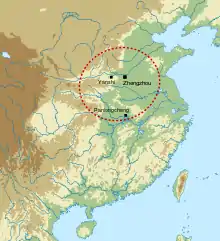Erligang culture
The Erligang culture ([âɚ.lì.kàŋ]) is a Bronze Age urban civilization and archaeological culture in China that existed from approximately 1510 to 1460 BC. The primary site, Zhengzhou Shang City, was discovered at Erligang, within the modern city of Zhengzhou, Henan, in 1951.
 | |||||||
| Geographical range | North China Plain | ||||||
|---|---|---|---|---|---|---|---|
| Period | Bronze Age China | ||||||
| Dates | c. 1510 – c. 1460 BC | ||||||
| Type site | Erligang | ||||||
| Major sites | Zhengzhou, Yanshi, Panlongcheng | ||||||
| Preceded by | Erlitou culture | ||||||
| Followed by | Shang dynasty | ||||||
| Chinese name | |||||||
| Traditional Chinese | 二里崗文化 | ||||||
| Simplified Chinese | 二里岗文化 | ||||||
| |||||||
Major sites
The culture was centered in the Yellow River valley. In its early years, it expanded rapidly, reaching the Yangtze River. The culture then gradually shrank from its early peak.
Zhengzhou
Later investigations showed that the Erligang site was part of an ancient city surrounded by a roughly rectangular wall with a perimeter of about 7 kilometers (4 mi). The walls were of rammed earth construction, a technique dating back to Chinese Neolithic sites of the Longshan culture (c. 3000–1900 BC). It has been estimated that the walls would have been 20 meters (66 ft) wide at the base, rising to a height of 8 meters (26 ft). Large workshops were located outside the city walls, including a bone workshop, a pottery workshop and two bronze vessel workshops. The modern city sits on the remains of the Erligang city, rendering archaeological excavations impossible. Therefore, most of the information about the culture comes from studying other Erligang sites.
Panlongcheng
The large site at Panlongcheng, on the Yangtze River in Hubei, is currently the largest excavated site of Erligang culture. It was discovered in 1954, and excavated in 1974 and 1976. Since Zhengzhou lacked access to local bronze metals, sites like Panlongcheng were probably used to secure distant metal resources.
Bronze vessels
Erligang bronzes developed from the style and techniques of the earlier Erlitou culture, centered at 85 kilometers (53 mi) to the west of Zhengzhou. Erligang was the first archaeological culture in China to show widespread use of bronze vessel castings. Bronze vessels became much more widely used and uniform in style than at Erlitou.
Relation to traditional accounts
Many Chinese archaeologists believe that the ancient city of Zhengzhou was one of the early capitals of the Shang dynasty mentioned in traditional histories. However many scholars and Western archaeologists have pointed out that, unlike the later Anyang settlement, no written records have been found at Erligang to link the archaeological remains with the official history.
References
- Bagley, Robert (1999), "Shang Archaeology", in Loewe, Michael; Shaughnessy, Edward L. (eds.), The Cambridge History of Ancient China, Cambridge: Cambridge University Press, pp. 124–231, ISBN 978-0-521-47030-8.
- Liu, Li (2003), "The products of minds as well as of hands: production of prestige goods in the Neolithic and early state periods of China", Asian Perspectives, 42 (1): 1–40, doi:10.1353/asi.2003.0025.
- Liu, Li; Chen, Xingcan (2012), The Archaeology of China: From the Late Paleolithic to the Early Bronze Age, Cambridge University Press, ISBN 978-0-521-64310-8.
Further reading
- Fong, Wen, ed. (1980). The great bronze age of China: an exhibition from the People's Republic of China. New York: The Metropolitan Museum of Art. ISBN 978-0-87099-226-1.
- Li, Feng (2013). Early China: a social and cultural history. New York: Cambridge University Press. ISBN 978-0-521-71981-0.